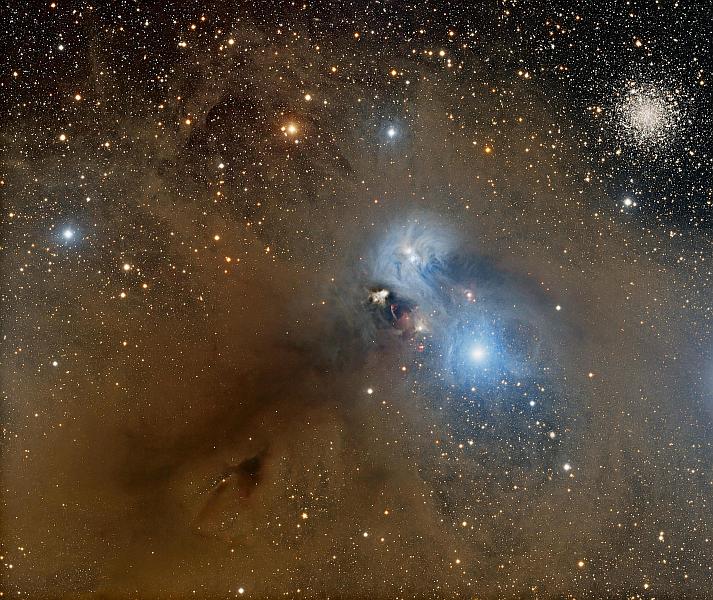NGC 6726 and Company |
 |
| Corona Australis (Latin for Southern Crown)
lies just south of Sagittarius. While it is considered a
southern constellation, it is just far enough north to be among
the 88 modern constellations that was among the 48 listed in the
2nd century by Ptolemy. Within the boundaries of this constellation lies this complex of various deep sky objects. There are a lot of objects in this image (please hover your cursor over the preview for an annotated version). Usually this region is listed by many imagers (as well as myself) by the brightest reflection nebula in the image, NGC 6726. That said, there are quite a number of other objects of different classifications in this image. As mentioned earlier, NGC 6726 is a reflection nebula. This is a region of dust reflecting the light of nearby bright stars. They are glowing blue for the same reason the Earth's sky is blue: blue light is scattered more effectively than other wavelengths. The HH, or Herbig-Haro objects, are regions of nebulosity associated with newborn stars. Jets of partially ionized gas ejected by these young stars are colliding with nearby clouds of gas and dust at high speed (several hundred kilometers per second). Bernes 157 is a dark nebula, a predominantly dusty region blocking the light of stars behind it. Its darkness shrouds the young stars that are also forming within this (surprise!) star-forming region. NGC 6723 is a globular cluster, one of over a hundred spherical, densely-packed clusters of ancient stars orbiting the Milky Way. This striking formation of objects is also a showcase of various distances. The majority of the objects shown are about 430 light-years away, making them one of the closest star-forming regions to the Solar System. In stark contrast, NGC 6723 is about 28,000 light-years distant! This image is the first dataset captured specifically for me by award-winning astrophotographer Martin Pugh, host of a remote observatory in New South Wales, Australia, as part of a data subscription offered. |
| Constellation: Corona Australis |
| When Visible: July - September |
| Distance: 430 light-years (except for NGC 6723, which is 28,000 light-years) |
| Date: July 2019 |
| Location: Yass, New South Wales, Australia |
|
Exposure Details: L: 13 x 20 minutes Binned 1 x 1 R: 9 x 20 minutes Binned 1 x 1 G: 9 x 20 minutes Binned 1 x 1 B: 9 x 20 minutes Binned 1 x 1 13 hours and 20 minutes total exposure time |
|
Equipment Used: Optics: Astro-Physics 305 mm f/3.8 Riccardi-Honders Astrograph Mount: Software Bisque Paramount MEII Camera: SBIG STXL-16200 camera |
| Acquisition Software: TheSkyX |
| Processing Software: MaximDL, Photoshop CS5, IrFanView, HLVG Plugin, Carboni Actions, Starizona Actions, AviStack, IrFanView |
